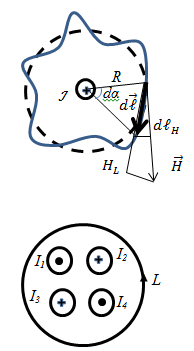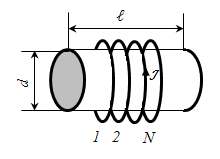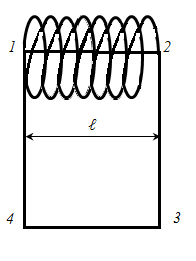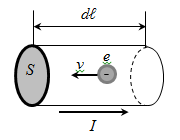main
To the list of lectures
|
§ 3 the Law of the total current. Vortex nature of the magnetic field
where
Law of the total current: Circulation of vector
Positive are those currents, the direction of which to the direction of passage of obeys the right hand rule. Currents, whose direction is opposite to bypass, taken with the minus sign.
§ 4 A magnetic field the solenoid and toroid
Solenoid is cylindrical shell, which are wound windings of wire. Consider an infinitely long solenoid, ie solenoid which ℓ >> d, where ℓ - length , d –diameter of the coil. Inside such a solenoid magnetic field is uniform. Uniform is a field, the field lines are parallel and their density is constant.
Apply the law
of the total current to calculate the magnetic field of the solenoid.
Represent the contour L, which is considered by the circulation of the
vector
because we have chosen the area 3 - 4 far enough from solenoid and one can assume that the field far from the solenoid is zero,
Circuit L includes N currents, where N - number of turns the solenoid, then the law of the total current
- The magnetic field of an infinitely long solenoid n - winding density - the number of turns per unit length The field intensity inside the solenoid is equal to the number of turns per unit length of the solenoid, multiplied by the current.
where
if R >>Rturn, then R ≈r and H = nI.
§5 Ampere force
The Ampere force (or Ampere's law) The direction of the Ampere force is situated by the rule of the vector product - on left-hand rule: four elongated fingers of his left hand placed on the direction of the current, vectorModule of Ampere force
where α –- the angle between the vectors If the field is uniform, and the current-carrying conductor of finite size, the
At
2. Definition of the unit of measurement of the current. Any current-carrying conductor generates a magnetic field around itself. If you put it in the field of the other current-carrying conductor, the conductor between the forces of interaction. In this case, co-directional parallel currents attract each the opposite direction - are repelled
Consider two infinitely long parallel conductors with currents I1 and I2, in a vacuum at a distance d (for vacuum μ = 1). According to Ampere's law
A magnetic field of direct current is
then
the force per unit length of the conductor
The force per unit length of the conductor between two infinitely long conductor with a current directly proportional to the current in each conductor and inversely proportional to the distance between them.
Definition of the unit of measurement of the current - Ampere: Per unit of current in the SI in place a DC current which is flowing in two infinitely long parallel conductors infinitesimal cross section, located in vacuum at a distance of 1 m from each other, is the force exerted per unit length of the conductor is equal to 2·10-7 N.µ = 1; I1 = I2 = 1 A; d = 1 m; µ0 = 4π·10-7 H/m –magnetic constant .
§6 The Lorentz force Under the Ampere’s law, force acting on the current element
Consider that the elementary current is none other than the directional movement of electric charges
where V –volume , n –the carrier density , j –current density , S – cross-sectional area of the conductor, e – electron charge (e = 1,6·10-19 C), dl - the element length of the conductor,
Ampere force acting on the elementary current
This force is called the Lorentz force:
|







